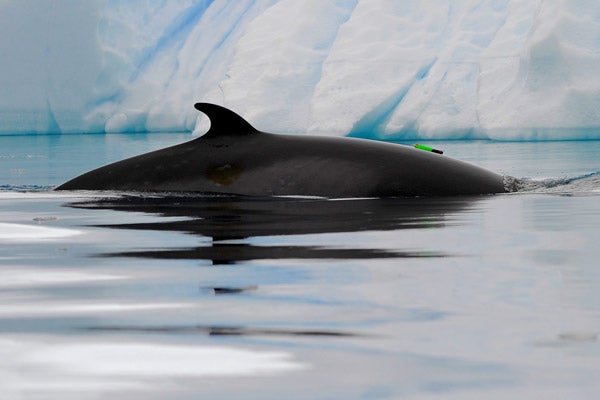|
August 14, 2014
Stanford researcher gets first-time look at Antarctic minke whales feeding
An international team of researchers that included a Stanford scientist used digital tagging technology to study the unique feeding habits of Antarctic minke whales. Understanding how minke whales feed may explain how whales became the largest animals of all time – and also lead to better protection for them. By Shara Tonn

Digital tagging technology allows Stanford biologist Jeremy Goldbogen to study the feeding behavior of minke whales in the Antarctic. (Photo: Ari Friedlaender)
The fossil record holds many secrets, but the largest animal in history – the whale – is not one of them. Dwarfing dinosaurs, mammoths and elephants, whales are the giants of both the past and present animal realms. But how did they get to be such behemoths?
Using improved technology, an international team of researchers – including a Stanford scientist – was able to tag and study the minke whale, a wily species whose feeding behavior could hold the key to understanding the evolution of a unique whale family called rorquals, which range in size from 16-foot-long minke whales to 92-foot-long blue whales. Their research was recently published in the Journal of Experimental Biology.
To put it into basketball terms, minke whales would reach from the basket to the free throw line, whereas blue whales would reach roughly the whole length of the court.
"If you look through the fossil record, you don't see anything bigger than a blue, fin or humpback whale," said Jeremy Goldbogen, assistant professor of biology at Stanford's Hopkins Marine Station and a member of the research team.
'Lunge feeding' characteristic
Minke whales and other species in the rorqual family are characterized by a feeding strategy called lunge feeding. During a lunge, rorquals accelerate to a high speed and ram the water with their mouths open, gulping down massive amounts of water and prey in just a few seconds.
Then, they filter the water out through baleen plates, which form a mat of keratin – the same fibrous protein in hair, feather and hooves – that hangs down from the top of their mouths, leaving the krill and other suspended zooplankton inside to swallow.
"There's no other animal that feeds like it, and it's thought to be why baleen whales have been able to get so big," Goldbogen said. "They're able to be energetically efficient so they can process and eat a lot of animals in a small amount of time."
According to Goldbogen, this feeding method evolved in rorqual ancestors that were similar in size to the minke whales of today.
"We do see anatomical evidence that suggest lunge feeding capability in small minke-size rorqual fossils," he explained. "Understanding how minke whales feed can tell us a lot about how lunge feeding evolved and how that innovation may have facilitated the evolution of the largest animals of all time."
Small size helps
Though minkes are one of the most common baleen whale species in the ocean, they are difficult to study because they're fast, they spend a great majority of their time under the sea surface and their feeding haunts change from year to year.
Due to their agility and small size, they have developed a niche feeding around and underneath sea ice – a habitat that other whales (and sometimes ships) are too big to access and one that is rapidly disappearing.
Goldbogen and his team chose digital tags to track the minke whales. The multi-sensor tags can record pressure, temperature, acceleration and orientation relative to the magnetic field, helping researchers understand what the whales are doing at depth. With a smart phone, one can interact with some of this technology when the phone is turned 90 degrees and the screen switches its orientation.
But the challenge is attaching the tags to the slippery whale blubber of the minkes. To overcome that, Goldbogen and his team used digital tags with suction cups on the bottom. With persistence, they managed to tag two Antarctic minke whales and track them for a combined total of 27 hours before the tags fell off and the scientists could retrieve them. They found that in one dive – defined as anytime the whale leaves the surface – a minke whale can ram-feed up to 24 times, which is five to eight times more than a blue or fin whale.
It makes sense, Goldbogen said, because larger whales have to spend a disproportionate amount of energy to propel themselves forward to take relatively bigger gulps. For the smaller minke whale, a lunge is the energetic equivalent of steady swimming.
But how often do they feed and how much caloric fuel do they consume? What are the upper and lower body size limits for whales that practice this type of suspension feeding strategy?
Those are questions that Goldbogen hopes longer-term tagging technology with better marine adhesives will be able to answer. And by piecing together the underwater life of the minke whale, Goldbogen said this research could be applied to conservation strategies in the future.
"If there are major changes in the ocean, that does affect sea ice, for example," he explained. "We might be able to project how that might affect minke whale foraging success. That might help us manage those populations."
But for now, Goldbogen wants to continue studying the filter feeding of minke whales and explore how it is related to the evolution of Earth's titans.
"We're really living in the time of giants," Goldbogen said. "It's a spectacular opportunity for biologists because now we have the technology in the form of these tags that we can use in order to study the biggest animals of all time."
Shara Tonn is an intern with the Stanford News Service.
For more Stanford experts on biology and other topics, visit Stanford Experts.
-30-
|